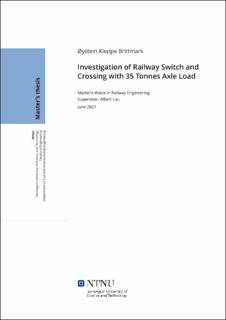| dc.contributor.advisor | Lau, Albert | |
| dc.contributor.author | Brittmark, Øystein Kleppe | |
| dc.date.accessioned | 2021-10-03T16:41:36Z | |
| dc.date.available | 2021-10-03T16:41:36Z | |
| dc.date.issued | 2021 | |
| dc.identifier | no.ntnu:inspera:80614265:18130206 | |
| dc.identifier.uri | https://hdl.handle.net/11250/2787268 | |
| dc.description.abstract | Økning av volum og vekt av godset som transporteres på tungtransport jernbanelinjer er en måte å øke kapasitet og kostnadseffektiviteten. I tillegg har økt aksellast innvirkning på dynamiske krefter og laster. Ytelse og oppførsel på sporet blir også påvirket, spesielt i kurver og i mer komplekse konstruksjoner, slik som sporveksler.
I denne studien undersøkes kjent teori og tidligere studier gjennom et litteraturstudium av emnet, inkludert arbeid gjort omhandlende forbedring av ytelse i sporveksler. Effektene av økt aksellast fra 30 til 35 tonn i en sporveksel er simulert ved hjelp av den kommersielle \textit{Multibody Simulation}-verktøyet GENSYS. Gjennom undersøkelser av sporveksel i alle retninger fremover blir kontaktpunktets areal, dets posisjon, samt påkjenninger og slitasje evaluert og sammenlignet gjennom en 60EI-R760-1:15 sporveksel hvor bytte- og krysspanelet er separert. Videre er overhøyde og sporvidde endret for å finne effektene av endring i ytelse og slitasje ved bruk av Perace \& Sherratts prediksjonsmetode for slitasje. Denne undersøkelsen blir gjort gjennom både bytte- og krysspanelet.
Resultatene som ble funnet viser at bredere sporvidde gir signifikante fordeler i det rette sporet i byttepanelet. Færre kontaktpunkter og bedre styring i det rette sporet i byttedelen ble observert. I avvikersporet i byttepanelet er fordelene derimot mindre betydelige. Fordelene i krysspanelet var ikke like signifikante, men i enkelte tilfeller ble det observert at bredere sporvidde var fordelaktig. Smalere sporvidde var generelt ikke fordelaktig, da det generelt resulterte i mer komplekse kontaktpunktstilstander samt hjulflens kontakt i de fleste tilfeller i både bytte- og krysspanelet. Introduksjon av overhøyde i avvikersporet endret også egenskapene på både fordel- og ufordelaktige måter. Mer overhøyde førte til økt sidevegs bevegelser i avvikersporet, spesielt i byttepanelet, men mangel på overhøyde ble til en viss grad eliminert. Det ble funnet ut at ved introduksjon av en beskjeden overhøyde ytelsen var bedre enn ved en høyere overhøyde i mange tilfeller. Resultatene viste også at før man introduserer overhøyde i sporveksler, er det anbefalt å undersøke hjul-skinne interaksjonenene som oppstår.
Resultatene fra denne avhandlingen samt konklusjonene som har blitt trukket kan bli brukt ved planlegging og prosjektering av sporveksler for tungtransport jernbanelinjer, da det er forventet at lastene vil øke. | |
| dc.description.abstract | Increasing the gross volume and weight of freight on heavy haul lines is a way to increase the capacity and the cost efficiency. In addition, the increased axle load has an impact on the dynamic forces and the loads. The performance on track is also affected, especially in curves and more complex structures, such as switches and crossings.
The following study investigates known theory and previous studies through a literature study on the subject, including work on increasing the performance of switches and crossings. The effects of increasing axle load from 30 to 35 tonnes in a railway switch and crossing are simulated using the commercial Multibody Simulation software GENSYS. Through investigating the railway switch and crossing in all directions in the facing move, the contact patch area, the position and the stresses as well as the wear rate have been evaluated and compared through a 60EI-R760-1:15 switch and crossing divided into switch panel and cross panel. Further, cant and track gauge was altered to find effects of changes in performance and wear using the Pearce \& Sherratt wear prediction method, through switch panel and crossing panel.
The obtained results show that a wider track gauge gives significant advantages in the through route in the switch panel. Fewer contact points and better steering in the through route in the switch panel were observed. In the diverging route in the switch panel, however, the the benefits are minor. Benefits in the crossing panel were not as significant, but in some cases it was observed that a wider gauge was beneficial. A narrower gauge was in general not favourable, resulting in more complex contact conditions and also flange contact in most cases in both switch panel and crossing panel. Introducing cant in the diverging route also altered the properties in both beneficial and non-beneficial ways. With more cant, an increased lateral movement in the diverging route was observed, especially in the switch panel, but the cant deficiency was somewhat eliminated. A shallow cant was found to perform better than a higher cant in many cases. Results also show that when introducing cant in switches and crossings thorough investigations into wheel-rail interaction is recommended.
The results and conclusions from this thesis could be used when designing switches and crossings for heavy haul lines in the future, as axle loads are expected to increase. | |
| dc.language | eng | |
| dc.publisher | NTNU | |
| dc.title | Investigation of Railway Switch and Crossing with 35 Tonnes Axle Load | |
| dc.type | Master thesis | |
